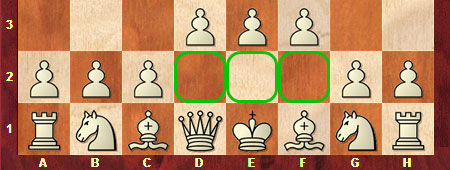
This is done by right clicking it, choosing properties from the menu, and checking the box which specifies this function. Any game database in CB can be “tagged” as your repertoire database. What follows is a discussion of various ways you can use this database type during the initial phase of personal repertoire construction. The Lines of Play databases will be one of the most useful databases for this purpose. This is the foundation upon which you will begin the construction of your personal repertoire database for the Black pieces. The plan laid out in the previous paragraphs will soon get you an impressive amount of repertoire work organized into folders. Here is a continuation:Įnroute to Building Your Personal Repertoire Database The article was not complete so I guess I should add a bit more. Otherwise, I really liked what you added. Regarding your #2 point, I would prefer to put that excellent idea to use in Tier 4. However, if used properly (i.e relying on yourself rather than Rybka/Fritz/Junior et al), I have little doubt that many players rated over 2200 would experience a large improvement as a result of their work. I would argue that this amount of depth in one's opening study would not be required by the vast majority of chess players. However, it should also include making the maximum use of the position search in conjunction with the manoeuvres search, in order to filter out games that are irrelevant to the types of middlegame/endgame positions you are seeking to study.

I agree that your suggested title for Manoeuvres Searches is an appropriate one, and a detailed section on this feature would be excellent. This also has the advantage of assisting them when they face their Black opening(s) as White. Equal NQE's arising from the opening should be included (particularly given that this process is being used for one's Black repertoire), and even ones that are favourable for White, so that the person using the files are aware of which endgames to avoid as Black.

The database should not be limited to NQE's that are favourable for Black, either. According to GM Glenn Flear (who invented the name 'Not Quite An Endgame'), a NQE is a position with two pieces (other than pawns and kings) on the board. Personally I think that understanding the endgames arising from an opening is essential enough to merit an extra folder in Tier 3, but it is a matter of taste. What I should have said instead of proposing the Endgames to go in 'Tier 5' was to instead place an Endgames folder in 'Tier 3' with the 'Typical Endgames' and 'Typical NQE's' in Tier 4. Maybe there are more economical and efficient methods that can be described by others. Like the others who posted, I think this topic is very interesting and practical. I hope there will be more posts about this repertoire-building process. I guess your Manoeuvres Search could be included in a section called Using Manoeuvres Search to Gather Personal Repertoire Files. I'm assuming that your NQEs are positions in your repertoire that are almost ready to be converted into favorable endings (ie. I meant to say that I would put Typical Endings and NQEs in one or two Folders in Tier 4. Having a 5th Tier for 'Typical Endgames' and 'Typical NQE's' (A NQE is a 'Not Quite an Endgame' see Flear's "Practical Endgame Play - Beyond the Basics") So every day i need to synchronize the databases.ġ. Th eonly problem is if one work on a different PCs (as is my case). I am trying to keep the files (except those which can be easily copied from the original disk) at least to 3 different medias - hard disk, DVD and flash memory. Of course weekly backups of this information is very important.
#What do the colored arrows in fritz chess mean how to#
I remember i got the idea from Kongstead's book - How to use computer to improve your chess. It is easy also to search in more than one database.

So when I need something I easily can find it in the right database. My analysis database grows every day (more than 100 MB already). I spent about 2-3 months in organising the things, but after this I am like a fish in a sea. Also two separate databases for my OTB and correspondence games. I have also so called analysis database where I store all interesting games, analysis and my own work. I have created my own repertoire database (you can find an article on chessbase site how to do that) where I store my openings - one database for each opening i play. In fact I use 4-5 reference databases such as Megabase, NICYB-base (i spent a lot of time collecting all the games from NIC Yearbook, puting them together and classifying them), Informant, Correspondence, etc.


 0 kommentar(er)
0 kommentar(er)
